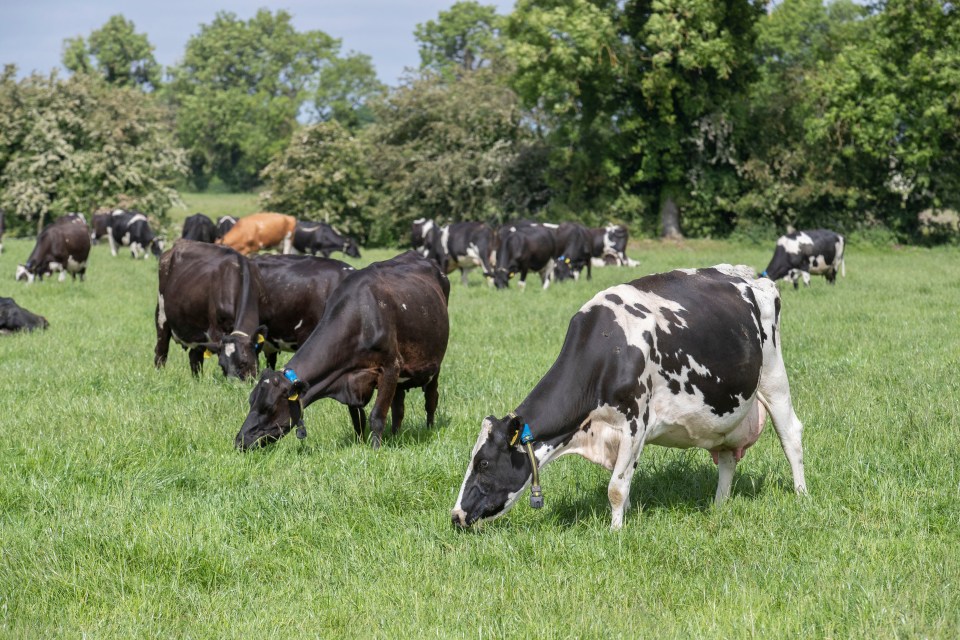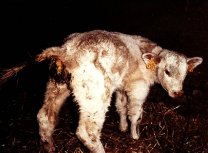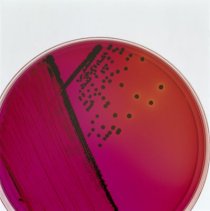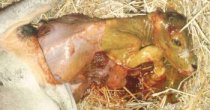
Salmonellosis
A page about salmonellosis in cattle, including factors that influence disease, clinical signs and how to control it.
Introduction
Salmonellosis, also known as salmonella infection, is caused by a family of bacteria with thousands of members most of which can affect all species and which infected animals can eliminate in a period of weeks. Salmonella dublin is one member which is species adapted to infect cattle and as such a carrier state exists. This means that once an animal is infected a high proportion fail to clear infection fully and will shed bacteria later in life in times of stress etc. The other prevalent strain in Ireland is Salmonella typhimurium which can affect a wide range of species including man. The clinical consequences of infection are determined by the strain of bacteria, the immune resistance of the animal infected and the amount of bacteria taken in. Various strains have varying ability to cause mild or serious disease.
Aetiology
Salmonellosis is caused by a family of bacteria with thousands of members most of which can affect all species and which infected animals can eliminate in a period of weeks. Salmonella dublin is one member which is species adapted to infect cattle and as such a carrier state exists. This means that once an animal is infected a high proportion fail to clear infection fully and will shed bacteria later in life in times of stress etc. Salmonella dublin can also infect man but clinical signs are rare – though case fatality is high. The other main member which occurs in cattle in Ireland is Salmonella typhimurium, which can infect many species including man.
Epidemiology
The clinical consequences of infection are determined by the strain of bacteria, the immune resistance of the animal infected and the amount of bacteria taken in. Various strains have varying ability to cause mild or serious disease. Immunity can be lowered by feed shortage, inclement weather, transport, dietary change, stress of calving etc. Other concurrent diseases may influence the severity of an outbreak including BVD and liver fluke infestation.
Another important factor in the success of salmonellosis is the wide host range including wild birds and rodents which maintain the organism in a herd and the disease can also get in through contaminated feed or water. Not only is the disease maintained by these mechanisms and the carrier-state, it is also quite persistent in the environment and is relatively resistant to adverse weather conditions. It can persist in dried faeces / dust for years and can last on pasture or in slurry for several months.

Clinical Signs
There are two main forms of disease in cattle – Diarrhoea and Abortion which can occur together or independently of one another. It is however unusual to have both syndromes on a farm at the same time.
1) Diarrhoea
Clinical signs can vary from very mild diarrhoea to those which show obvious signs of fever, dehydration and profuse watery diarrhoea followed by death in a few days. Many of the cohort animals may be at various stages of disease.
The disease can also resemble an outbreak of pneumonia in young calves without any signs of diarrhoea. Calves may subsequently develop gangrene of the feet, ear tips or tail as a consequence of septicaemia. Chronic salmonellosis results in chronic diarrhoea. These animals are commonly carriers of disease and shed organisms intermittently.
2) Salmonella induced abortion
This syndrome is commonly associated with Salmonella dublin infection. Abortion usually occurs in the last third of pregnancy. Abortion is often associated with retention of the foetal membranes. While cows are often clinically ill and mortality may subsequently occur, there may be no accompanying signs at all – with abortion occurring weeks after an inapparent primary infection.

Diagnosis
Clinical signs of salmonellosis are indicative of infection but laboratory tests are required for a definitive diagnosis. Often scour or abortion in cattle are caused by multiple concurrent viral and bacterial infections. Laboratory tests are required for a specific diagnosis.
Laboratory investigation
Antibody testing
Retrospective diagnosis of salmonella infection can be made by measuring antibody levels in paired sera samples. First sample is collected during the clinical phase and a second sample is collected 4 weeks later.
Isolation of the organism
Samples that can be submitted for culture and identification of salmonella as the causal agent in disease include diarrhoea, aborted foetuses or uterine discharge. The organism may also be isolated from samples taken during post-mortem examination
Post mortem examination
Salmonella infection is commonly fatal. Characteristic pathology may be evident on gross post mortem which may be confirmed by culture.

Control
Control of salmonellosis is based on four equally important aspects:
- Selective culling – Reduction of circulating bacteria can be achieved with the introduction of a vaccination program and progressive culling of those animals that are identified as a potential source of the bacteria. In most farms due to the high sero-prevalence it is not economically feasible to test and cull all the sero-positive animals. Furthermore the antibody test is not a highly reliable indicator of immune / exposure status.
- Biosecurity – Maintaining biosecurity involves avoiding introduction of infected animals into the herd and/or implementing stict isolation / quarantine of introductions until proven negative, and restricting access of livestock to external sources of infection e.g. double fencing is in place at all perimeters, restricting access of visitors to the farm etc.
- Vaccination – The use of vaccine is useful in reduction of the bacterial circulation, which has been proven in a study on S. typhimurium. Bovivac S is an inactivated vaccine for active immunisation of cattle to reduce the intensity and duration of the clinical signs induced by an infection with Salmonella dublin or S. typhimurium and to reduce excretion of S. typhimurium. For more information on the use of this vaccine click here. For vaccination schedule and data sheet details click here.
- Monitoring – This varies depending on the nature and risk status of your herd. Appropriate screening programmes can be discussed with your local veterinary practitioner.
